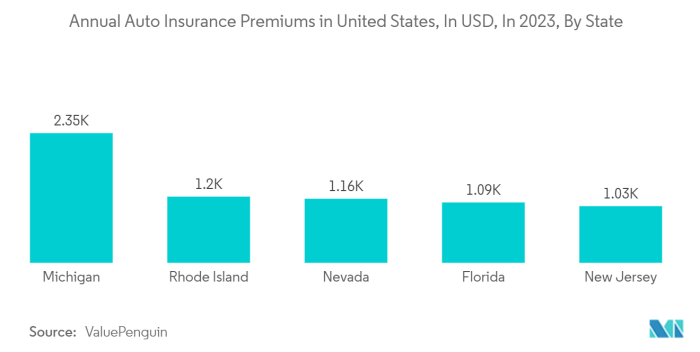Usage-based insurance (UBI) trends 2025 are totally blowing up! Forget your grandpa’s insurance – we’re talking about a future where your driving habits directly impact your premiums. Think of it: less speeding, smoother braking, and fewer late-night joyrides could mean serious savings. But it’s not all smooth sailing; privacy concerns and the tech behind it are major players in this evolving landscape.
This deep dive explores the tech, the consumer side, and the legal stuff shaping UBI’s future.
From the crazy advancements in telematics and data analytics to the regulatory hurdles and consumer anxieties, we’ll unpack how UBI is changing the game. We’ll examine how different pricing models are competing for your business, and what innovations are on the horizon, like AI and blockchain. Buckle up, because the ride’s about to get interesting.
Technological Advancements in UBI
Usage-Based Insurance (UBI) is rapidly evolving, driven by advancements in technology that are making it more accurate, personalized, and efficient. The convergence of telematics, data analytics, and the Internet of Things (IoT) is fundamentally reshaping the UBI landscape, leading to innovative solutions and a more dynamic insurance market.
Telematics in UBI
Telematics plays a central role in UBI, providing the crucial data needed to assess driver behavior and risk. These systems use GPS, accelerometers, and other sensors embedded in telematics devices to collect data on driving habits, such as speed, braking, acceleration, mileage, and even location. This data is then transmitted wirelessly to insurance providers, allowing them to develop highly personalized insurance premiums based on actual driving behavior rather than broad demographic categories.
For example, a driver with a consistently safe driving record, as evidenced by telematics data, might qualify for significant discounts, while high-risk drivers may see their premiums increase. This system encourages safer driving habits, leading to fewer accidents and lower insurance payouts.
Data Analytics and UBI Accuracy
Advancements in data analytics are critical to making UBI effective. Sophisticated algorithms are used to analyze the vast amounts of telematics data collected, identifying patterns and correlations that can predict future driving behavior and risk. Machine learning models are trained on massive datasets, enabling the development of more accurate risk assessment models that go beyond simple metrics like mileage.
These models consider a wider range of factors, such as time of day, location, weather conditions, and even the type of vehicle being driven, resulting in more personalized and equitable premiums. For instance, a model might identify that a driver is more likely to have an accident during rush hour in a specific area known for congestion.
IoT Devices and UBI Integration
The integration of IoT devices is expanding the capabilities of UBI systems. Wearable devices, smart home systems, and even connected cars can provide additional data points that enhance the accuracy of risk assessment. For example, data from a wearable device might indicate that a driver is drowsy or distracted, while data from a smart home system could reveal whether the vehicle is being driven by an authorized driver.
This richer data set allows for a more holistic understanding of driver behavior and risk, leading to even more accurate and personalized premiums. Consider a scenario where a smart home system detects a break-in, and subsequently the UBI system notices the associated vehicle is driven erratically—this might indicate a high-risk situation requiring immediate attention.
Comparison of Data Collection Methods in UBI
Different methods are used to collect data for UBI, each with its own strengths and weaknesses. Traditional telematics devices, typically plug-in devices, offer comprehensive data but may be less convenient for some drivers. Smartphone apps provide a more accessible option, but their data accuracy can be affected by factors such as signal strength and battery life. OBD-II port devices offer a balance of convenience and data richness, but require compatible vehicles.
The choice of data collection method often depends on factors such as cost, ease of use, and the level of data granularity required.
Telematics Device Comparison
| Device Type | Data Collected | Installation | Cost |
|---|---|---|---|
| Plug-in Device | Speed, acceleration, braking, mileage, location | Requires plugging into the OBD-II port | Moderate |
| Smartphone App | Speed, acceleration, braking, mileage, location (accuracy may vary) | Download and install app | Low |
| OBD-II Device | Speed, acceleration, braking, mileage, location, engine diagnostics | Requires plugging into the OBD-II port | Moderate to High |
| Integrated Telematics (OEM) | Comprehensive data, often including driver behavior metrics | Factory-installed | High (included in vehicle cost) |
Consumer Adoption and Perception of UBI
The adoption of usage-based insurance (UBI) is a complex issue, influenced by a multitude of factors ranging from consumer trust and technological comfort to the perceived value proposition and data privacy concerns. While the potential benefits of UBI, such as personalized premiums and safer driving incentives, are undeniable, widespread adoption hinges on effectively addressing consumer hesitations and building trust.Consumer acceptance of UBI is currently a mixed bag.
Early adopters are typically tech-savvy individuals who appreciate the potential for cost savings and personalized risk assessment. However, a significant portion of the population remains hesitant, primarily due to concerns about data privacy and the potential for misuse of their driving information. The key drivers of adoption include the promise of lower premiums for safe drivers, increased transparency in pricing, and the gamification aspects that encourage better driving habits.
However, these advantages must be weighed against the perceived risks.
Consumer Privacy Concerns in UBI
The core concern surrounding UBI revolves around data privacy. Consumers are understandably apprehensive about sharing intimate details of their driving habits, fearing potential misuse of this data by insurance companies or third parties. This includes worries about data breaches, unauthorized access, and the potential for discriminatory pricing based on factors beyond driving skill, such as location or socioeconomic status.
For example, concerns exist that data showing frequent trips to a specific doctor’s office might be interpreted as indicating a health condition unrelated to driving ability, unfairly influencing premium calculations. This lack of transparency and potential for misuse can significantly hinder widespread adoption.
Insurance Company Responses to Data Security Concerns
To address consumer anxieties, insurance companies are implementing various measures to enhance data security and transparency. Many are investing heavily in robust cybersecurity infrastructure, employing encryption techniques, and adhering to strict data privacy regulations like GDPR and CCPA. They are also proactively communicating their data handling policies, emphasizing the purpose of data collection, and outlining the safeguards in place to protect consumer information.
Furthermore, some insurers offer options for data anonymization or limited data sharing, giving consumers more control over their information. This proactive approach is crucial for building trust and fostering consumer acceptance of UBI.
So, UBI trends in 2025 are all about personalized risk assessment, right? A big part of that is how individual driving behavior impacts premiums, and a great example is Tesla’s approach. Check out how their safety score works: Tesla Insurance safety score explained. This kind of granular data analysis is what’s driving the future of UBI, leading to more tailored and potentially cheaper insurance for safe drivers.
Factors Influencing Data Sharing Willingness
Several factors influence a consumer’s willingness to share driving data. Trust in the insurance company plays a significant role; consumers are more likely to share data with companies they perceive as reputable and transparent about their data practices. The perceived benefits of data sharing, such as lower premiums or rewards, also influence this decision. Conversely, concerns about data security, lack of transparency in data usage, and the potential for price discrimination can significantly reduce willingness to share data.
Furthermore, the ease of data sharing and the level of control consumers have over their data are also crucial factors. A simple, user-friendly app and clear options for data management can encourage participation.
Survey Questionnaire to Assess Consumer Attitudes Toward UBI
To gain a comprehensive understanding of consumer attitudes toward UBI, a survey could be designed incorporating the following questions:
| Question Type | Question |
|---|---|
| Multiple Choice | How familiar are you with usage-based insurance (UBI)? (Very Familiar, Somewhat Familiar, Not Familiar at all) |
| Multiple Choice | Would you consider using UBI? (Yes, No, Maybe) |
| Multiple Choice | What are your primary concerns about UBI? (Data Privacy, Cost, Lack of Transparency, Other) |
| Rating Scale (1-5, 1 being strongly disagree, 5 being strongly agree) | I trust insurance companies to protect my personal driving data. |
| Open-Ended | What would make you more comfortable sharing your driving data with an insurance company? |
Regulatory Landscape and Legal Implications of UBI

The rapid growth of usage-based insurance (UBI) presents a complex interplay between technological innovation and established legal frameworks. Different regions are navigating this new landscape with varying approaches, leading to a diverse regulatory environment that significantly impacts UBI implementation and adoption rates. Understanding these legal and regulatory nuances is crucial for both insurers and consumers.
Current Regulatory Environment for UBI Across Regions
The regulatory landscape for UBI differs significantly across the globe. In the European Union, the General Data Protection Regulation (GDPR) heavily influences data collection and usage practices, demanding stringent consent mechanisms and robust data security measures. Conversely, the United States boasts a more fragmented regulatory environment, with individual states adopting their own approaches, leading to inconsistencies in UBI regulations and potential challenges for insurers operating nationwide.
In Asia, countries like China and Japan are beginning to develop their regulatory frameworks for UBI, focusing on data privacy and consumer protection. This variation necessitates a region-specific approach to UBI implementation, requiring insurers to adapt their strategies and comply with diverse legal requirements. For example, a UBI program operating in California needs to meet different standards than one operating in Germany, reflecting the varying levels of data privacy emphasis.
Data Collection and Usage: Legal Challenges and Risks
The core of UBI relies on the collection and analysis of vast amounts of driver data, including location, speed, acceleration, braking, and even driving style. This raises significant legal concerns regarding data privacy, security, and potential misuse. Legal challenges arise from the potential for data breaches, leading to identity theft or other forms of harm. Additionally, the use of this data for purposes beyond insurance risk assessment, such as targeted advertising or sale to third parties, could face legal scrutiny and consumer backlash.
Furthermore, algorithmic bias embedded in data analysis models could lead to discriminatory pricing practices, resulting in legal challenges based on fairness and equity. For instance, a poorly designed algorithm might unfairly penalize drivers in certain demographics.
Impact of Data Protection Regulations (e.g., GDPR) on UBI, Usage-based insurance (UBI) trends 2025
The GDPR, and similar regulations emerging globally, significantly impact UBI implementation. These regulations demand explicit consent for data collection, transparency about data usage, and the right to data access and erasure. Insurers must demonstrate compliance with these regulations, which involves implementing robust data security measures, establishing clear data governance policies, and providing individuals with control over their data.
Non-compliance can result in hefty fines and reputational damage. For example, an insurer failing to obtain proper consent for data collection under GDPR could face significant penalties. The impact of these regulations extends beyond Europe, influencing the design and implementation of UBI programs globally, setting a higher standard for data privacy and security.
Government Policies and UBI Adoption
Government policies play a crucial role in shaping UBI adoption rates. Supportive policies, such as data privacy frameworks that balance innovation with consumer protection, can foster UBI growth. Conversely, overly restrictive regulations or a lack of clear guidelines can hinder its development. Government initiatives promoting technological innovation and digital infrastructure can also contribute positively to UBI adoption.
Conversely, a lack of investment in digital infrastructure or a negative public perception of data collection could impede the growth of UBI. For example, government subsidies for telematics devices could incentivize consumer adoption.
Key Legal Considerations for Insurers Implementing UBI Programs
The successful implementation of a UBI program necessitates careful consideration of several key legal aspects. Insurers need to proactively address these issues to mitigate potential risks and ensure compliance.
- Data Privacy and Security: Implementing robust data security measures to protect against breaches and unauthorized access.
- Consent and Transparency: Obtaining explicit and informed consent from policyholders regarding data collection and usage, and providing transparent information about data practices.
- Data Minimization: Collecting only the minimum necessary data for risk assessment and avoiding unnecessary data collection.
- Data Accuracy and Integrity: Ensuring the accuracy and reliability of collected data and implementing processes for data correction and updates.
- Algorithmic Fairness and Bias: Regularly auditing algorithms for bias and ensuring fair and equitable pricing practices.
- Compliance with Relevant Regulations: Adhering to all applicable data protection regulations, including GDPR, CCPA, and other relevant state and national laws.
- Data Retention and Disposal: Establishing clear policies for data retention and secure disposal of data after it is no longer needed.
- Cross-border Data Transfers: Complying with regulations governing the transfer of data across international borders.
UBI Pricing Models and Competitiveness
Usage-based insurance (UBI) is shaking up the insurance industry, and a key driver of this disruption is the diverse range of pricing models insurers are employing. These models, along with broader market forces, significantly impact the competitiveness of UBI offerings and the overall insurance landscape. Understanding these dynamics is crucial for both insurers and consumers.
Currently, several UBI pricing models are competing for market share. These models differ in their complexity, data requirements, and ultimately, the premiums they generate. The choice of model significantly influences the fairness, transparency, and competitiveness of the UBI offering.
Comparison of UBI Pricing Models
Several key UBI pricing models exist, each with its own strengths and weaknesses. A common model is the pay-per-mile model, where premiums are directly tied to the number of miles driven. Another approach uses a score-based system, integrating various driving behaviors like acceleration, braking, and time of day into a composite score that determines premiums. Finally, some insurers combine these approaches, creating hybrid models that leverage both mileage and driving behavior.
The pay-per-mile model offers simplicity and transparency, but may not fully capture the risk associated with different driving styles. Score-based models offer more nuanced risk assessment but can be more complex to understand and potentially less transparent. Hybrid models attempt to balance these aspects, but require sophisticated data analysis and algorithms.
Factors Influencing UBI Competitiveness
Several factors beyond the pricing model itself significantly impact the competitiveness of a UBI offering. These include the accuracy and reliability of the telematics data used, the user-friendliness of the associated mobile app or device, the overall customer service experience, and the insurer’s brand reputation. A highly accurate and reliable telematics system that provides consistent and fair pricing is essential.
A poorly designed app or a lack of responsive customer service can quickly erode customer trust and satisfaction, negatively affecting competitiveness. Insurers with a strong brand reputation and a history of customer-centric practices tend to have a competitive advantage in the UBI market. The availability of additional features and benefits, such as discounts or bundled services, also plays a role.
Optimizing UBI Pricing for Fairness and Transparency
Fairness and transparency are critical for building consumer trust in UBI. To achieve this, insurers need to clearly communicate how premiums are calculated, making the process easily understandable to the average consumer. Regular audits of the pricing algorithms and data used are crucial to ensure accuracy and fairness. Additionally, mechanisms for appealing premium calculations or addressing disputes should be readily available.
Providing clear explanations of how driving behaviors impact premiums, and offering personalized feedback to help drivers improve their scores and potentially lower their premiums, can also enhance both fairness and transparency. This proactive approach fosters a positive customer experience and builds trust.
Impact of UBI on the Insurance Market
UBI is poised to significantly reshape the insurance market, introducing new levels of competition and innovation. By offering personalized premiums based on individual driving behavior, UBI has the potential to reduce premiums for safe drivers while encouraging safer driving practices overall. This can lead to a more equitable distribution of insurance costs, reducing the burden on responsible drivers who subsidize higher-risk drivers in traditional insurance models.
Usage-based insurance (UBI) trends in 2025 are all about personalized pricing, making it super relevant for small businesses. Check out the options for Commercial auto insurance for small businesses to see how these savings could impact your bottom line. Ultimately, UBI’s focus on driving behavior will continue to shape the future of commercial auto insurance premiums.
The increased competition among insurers is also likely to drive innovation in telematics technology and data analytics, leading to more sophisticated and accurate risk assessment. However, it is also important to consider the potential for increased data privacy concerns and the need for robust regulatory frameworks to ensure fair and responsible UBI practices.
Design of a Dynamic UBI Pricing Algorithm
A dynamic UBI pricing algorithm should adapt to changing driver behavior over time. This algorithm could incorporate a weighted average of recent driving data, giving more weight to recent driving behavior than older data. For example, a driver who consistently maintains a high safety score over several months might see their premiums decrease, while a driver who exhibits risky behavior might experience an increase.
The algorithm could also adjust the weighting based on the overall volatility of the driver’s behavior. A driver with consistently stable driving patterns might require less frequent adjustments than a driver with erratic behavior. The algorithm could also incorporate external factors, such as weather conditions or traffic congestion, to further refine the risk assessment. For instance, a higher number of accidents in a particular area could temporarily adjust the algorithm to account for increased risk in that location.
This dynamic approach ensures that premiums accurately reflect current driving habits and adapt to changing circumstances, promoting both fairness and accuracy in pricing.
Future Outlook and Innovation in UBI: Usage-based Insurance (UBI) Trends 2025

The future of Usage-Based Insurance (UBI) is brimming with potential, driven by rapid technological advancements and evolving consumer expectations. 2025 and beyond will likely see a significant shift towards more personalized, predictive, and integrated insurance solutions, moving beyond simple mileage tracking to encompass a much broader range of driving behaviors and lifestyle factors. This evolution will be shaped by the increasing sophistication of AI, ML, and other technologies, leading to a more nuanced and equitable pricing model for consumers.
Artificial Intelligence and Machine Learning in UBI
AI and ML are poised to revolutionize UBI. Beyond basic telematics data like speed and mileage, AI algorithms can analyze a wealth of contextual information – weather conditions, road type, time of day – to create a more accurate risk profile for each driver. Machine learning models can continuously improve their predictive capabilities by analyzing vast datasets of driving behavior and accident reports, leading to more precise pricing and personalized safety recommendations.
For example, an AI-powered system could identify a driver’s tendency towards aggressive braking and provide targeted feedback or even discounts for enrolling in a defensive driving course, demonstrating a proactive approach to risk management. This moves UBI beyond simply reacting to accidents towards actively preventing them.
Integration of UBI with Other Insurance Products and Services
The future of UBI likely involves seamless integration with other insurance products and services. We can expect to see bundled packages that combine UBI with home, health, or even life insurance, offering comprehensive risk management at a potentially discounted rate. Imagine a scenario where safe driving habits earn discounts not only on car insurance but also on home insurance premiums, reflecting a holistic view of risk assessment.
This integration would incentivize positive behavior across multiple areas of life, creating a virtuous cycle of safety and savings. For instance, a company might offer lower premiums on both car and home insurance to customers who demonstrate consistent safe driving and responsible home energy usage, monitored through smart home devices.
Blockchain Technology in UBI
Blockchain technology offers significant potential for enhancing security and transparency in UBI. By creating a secure and immutable record of driving data and insurance transactions, blockchain can build trust between insurers and policyholders. This transparency can help reduce disputes over premiums and claims, while also protecting sensitive driver data from unauthorized access. For example, a blockchain-based system could ensure that only authorized parties have access to a driver’s telematics data, preventing data breaches and maintaining privacy.
Furthermore, smart contracts on the blockchain could automate premium calculations and claims processing, streamlining the entire insurance process and reducing administrative costs.
Anticipated Evolution of UBI: A Visual Representation
The illustration would be a timeline spanning five years, from 2025 to The leftmost point (2025) depicts a simple icon representing basic telematics data collection (speed, mileage). As the timeline progresses towards 2030, the icon evolves to show increasingly complex data points being incorporated: contextual data (weather, road type), driver behavior analysis (acceleration, braking), integration with other devices (smart home, wearables), and finally, a fully integrated system utilizing AI, ML, and blockchain.
The size and complexity of the icon would grow proportionally to reflect the expanding capabilities of UBI over time. The colors could shift from a muted palette in 2025 to brighter, more vibrant tones by 2030, symbolizing the increased sophistication and efficiency of the system. The overall effect is to show a clear progression from a rudimentary system to a highly advanced, integrated, and secure platform.
Summary
So, what’s the bottom line on UBI in 2025? It’s a wild mix of promising tech, growing consumer adoption, and some serious legal and ethical questions. While privacy concerns are legit, the potential for personalized, fairer premiums is huge. As technology continues to advance and regulations adapt, UBI is poised to revolutionize the insurance industry, making it more responsive to individual driving behaviors and ultimately, more affordable for safe drivers.
It’s a game-changer, and it’s just getting started.









